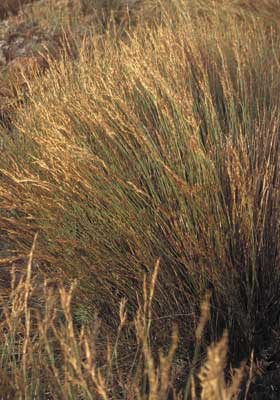 Sporadanthus ferrugineus. Photograph: Peter de Lange.New Zealand’s restiad bogs are most commonly found on low lying, flat and poorly drained environments but can also occur in montane and subalpine zones. The three main restiad bog species are:
Sporadanthus ferrugineus. Photograph: Peter de Lange.New Zealand’s restiad bogs are most commonly found on low lying, flat and poorly drained environments but can also occur in montane and subalpine zones. The three main restiad bog species are:
- Empodisma minus (found in North, South, and Stewart Islands)
- Sporadanthus ferrugineus (found in North Island)
- Sporadanthus traversii (restricted to the Chatham Islands)
Restiad bogs are those characterised by plant species of the Restionaceae family and are most extensively developed in New Zealand.
The Restionaceae comprises jointed rush-like herbs with rigid or flexuose above-ground stems and reduced scale-like sheathing leaves growing on low fertility, seasonally moist or wet soils.
 Sporadanthus traversii. Photograph:John Sawyer. For more information see:
Sporadanthus traversii. Photograph:John Sawyer. For more information see:
- Clarkson, BR, Clarkson BD 2006: Restiad bogs in New Zealand. In: Rydin, H and Jeglum, JK The biology of peatlands Chapter 11: Peatlands around the world: Restiad bogs in New Zealand. The Biology of Habitat Series Oxford University Press UK pp 228-233.
